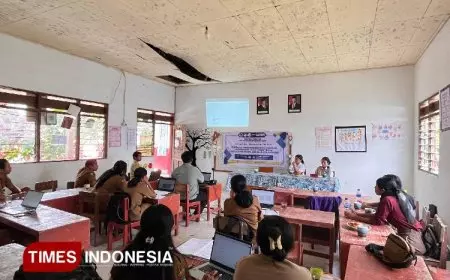Rupin Banker: The Effects of Financial Globalization on Developing Countries
Financial globalization has had a multifaceted impact on developing countries. On one hand, it has enabled access to large pools of capital, supported infrastructure development, and encouraged modernization of financial systems.

TIMES Network – Financial globalization has had a multifaceted impact on developing countries. On one hand, it has enabled access to large pools of capital, supported infrastructure development, and encouraged modernization of financial systems. On the other hand, it has exposed vulnerable economies to market volatility, widened socio-economic disparities, and created dependency on external financing.
While some countries, such as India and Kenya, have harnessed global finance to fuel growth and innovation, others have struggled with instability and social disruption. According to Rupin Banker, the effects vary across regions and depend on how well countries manage integration into the global financial system.
What Financial Globalization Means for Developing Countries
Financial globalization refers to the growing connection between national economies through international capital flows, investment, and the activities of global financial institutions. This has expanded rapidly over the past few decades, driven by advancements in technology and deregulation of financial markets.
In developing countries, financial globalization influences how economies grow and integrate into the global system. It creates opportunities for accessing international funding, attracting foreign investors, and modernizing financial sectors. Nations like Kenya and Bangladesh have engaged more deeply with global finance to support infrastructure and development goals. This integration often brings financial resources and international scrutiny, influencing policy direction and economic priorities.
Unlike broader globalization, which includes trade and cultural exchange, financial globalization focuses specifically on monetary and investment flows. It directly impacts domestic economies by shaping interest rates, credit availability, and the structure of banking and finance systems.
Main Channels of Financial Influence
Foreign Direct Investment (FDI) and portfolio flows are two major ways financial globalization reaches developing nations. FDI often brings not just capital but also management expertise and technology, while portfolio investments can provide liquidity to local markets. However, the latter can be more volatile and short-term in nature, sometimes leading to instability during economic downturns.
International capital markets give developing countries access to funding that may not be available domestically. Governments and companies raise funds through bonds or equity offerings, often to finance infrastructure, education, or healthcare. Countries like Nigeria and Peru have used sovereign bonds to tap into global investor interest. These instruments can also serve as benchmarks for private sector borrowing, facilitating broader access to finance.
Institutions such as the International Monetary Fund and the World Bank also play a considerable role. These organizations offer loans, policy advice, and technical assistance. Their presence in many developing economies has shaped reform agendas and influenced economic decision-making at national levels.
Economic Advantages Seen Across Regions
Financial globalization has helped accelerate infrastructure development by making capital more accessible. In Southeast Asia, increased foreign investment contributed to expanding transportation networks and energy projects, supporting broader economic growth. These investments also help create jobs and improve connectivity, which can stimulate further private sector activity.
Some economies have witnessed substantial improvements in their banking sectors. Liberalizing financial systems often invites competition, leading to modernization and better services. With this growth, countries like India have experienced a rise in financial technology adoption and wider access to banking.
Beyond capital, the transfer of skills and technology has created lasting benefits. When multinational corporations set up operations in developing countries, they introduce new systems, processes, and training, which enhance the capabilities of the local workforce.
Financial and Structural Challenges
While financial globalization opens doors, it also exposes developing economies to rapid shifts in global markets. Sudden reversals in capital flows or changes in investor sentiment can trigger financial instability, leading to currency depreciation or inflation spikes. Smaller economies often lack the tools to absorb these shocks smoothly, making them more vulnerable during global downturns.
Short-term speculative investments pose another risk. They can create asset bubbles and distort local markets, especially where regulatory frameworks are underdeveloped. Argentina’s history of financial crises highlights how volatility in foreign investment can undermine economic stability. Over-reliance on short-term capital can leave economies exposed to abrupt withdrawals during periods of uncertainty.
Maintaining economic sovereignty becomes more difficult as external financial pressures mount. When governments rely heavily on global capital, it can limit their ability to enact independent fiscal and monetary policies. This often leads to tension between national priorities and the expectations of international investors or institutions.
Broader Social and Labor Effects
The gains from financial globalization are not always evenly distributed. Wealthier urban centers tend to attract more investment, while rural areas may be left behind. This unevenness can deepen existing inequalities and create social tensions. Disparities in income and employment opportunities may increase if inclusive policies are not implemented alongside financial reforms.
Labor markets also shift as foreign capital prioritizes certain industries. In some countries, traditional sectors like agriculture have been overshadowed by rapid growth in finance or services, leading to job displacement. At the same time, new opportunities arise, though not always accessible to all segments of the population.
Financial inclusion remains a crucial issue. Despite the influx of capital, many people in developing nations continue to lack access to basic financial services. Limited banking infrastructure and digital divides often prevent the poorest communities from reaping the benefits of global finance. Bridging this gap requires targeted interventions and investments in financial literacy programs. (*)
Apa Reaksi Anda?




























































